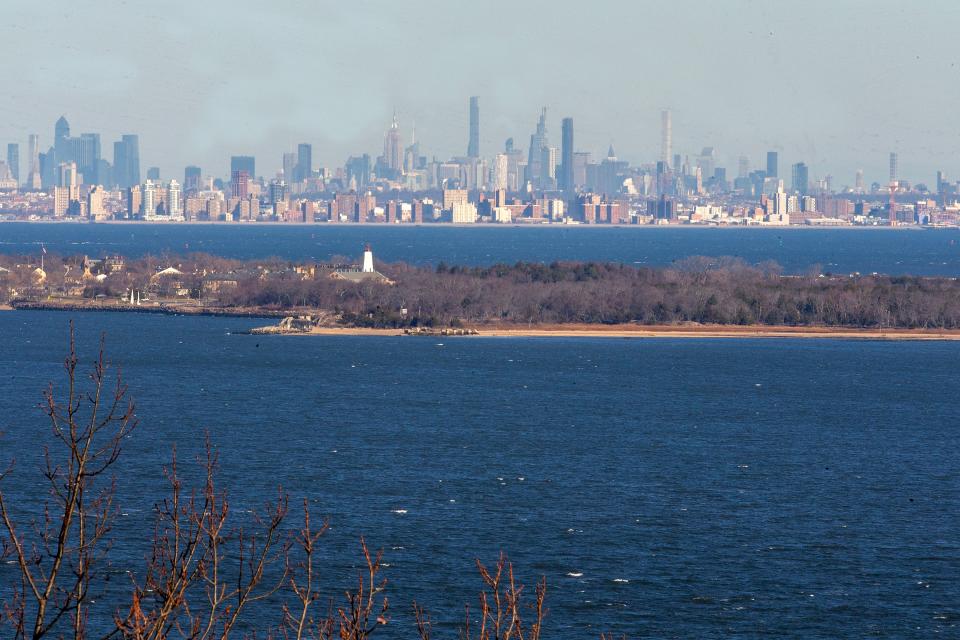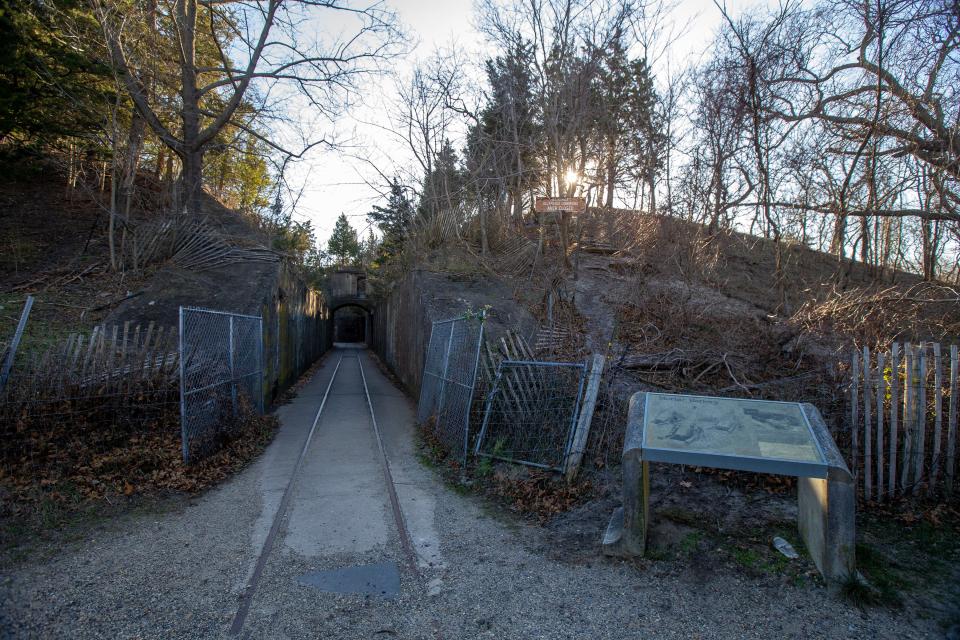Black loyalists fought for their freedom — and the crown — at Sandy Hook during Revolution
- Oops!Something went wrong.Please try again later.
"Ty, with his party of about 20 Blacks and whites, last Friday afternoon took off [captured] prisoners Capt. Barnes Smock and Gilbert Van Mater. … The above mentioned Ty, who wears the title of Colonel, commands a motley crew at Sandy Hook.”
The Pennsylvania Evening Post, which was the United States’ first daily newspaper, published the above dispatch from Middletown on June 16, 1780. There’s nothing exceptional on its surface. Raids and raiders were commonplace during the American Revolution, especially in the contested area along Monmouth County’s Bayshore.
But this story features one heck of a twist: Colonel Ty (Tye was the actual spelling) was an escaped local slave fighting with the British, and his “motley crew” included a few dozen Black loyalists who were promised freedom if they sided with the crown. Their encampment at Sandy Hook became known as Refugeetown — “where the horse thieves resort,” as the Evening Post reported.
How much did the patriots fear Tye?
“My favorite document about Tye is a muster roll from Middletown militia, which ran from Sandy Hook to Matawan,” said historian and author Michael Adelberg, who has written extensively about Tye and Refugeetown. “The local officer notes a terrible turnout and puts a very unusual note in it: ‘Refused to turn out because of Colonel Tye.'”

Revolutionary War history:Freehold barn, with beams burned by British and now sitting next to Walmart, may be saved
This story is not taught in schools, and it’s largely unknown by the general public, even in this history-rich area. That could change soon. Last week the New Jersey Historical Commission Awarded a $24,500 grant for the National Park Service to explore how to best commemorate Colonial Tye, his “Black Brigade” and Refugeetown as the nation’s 250th anniversary approaches in 2026. It’s a fascinating project because much of Tye’s riveting story remains shrouded in mystery.
“They had been written out of history,” said Monmouth University associate dean and anthropology professor Richard Veit, who is the leading archeological expert on Sandy Hook. “They were seen as being on the wrong side of the conflict. And it’s all incredibly ironic, because enslaved African Americans were seeking freedom during the revolution, and the way to secure that is with crown forces — not with the patriots.”
The hard truth at the core of Tye’s tale: During the vicious house-to-house combat that unfolded throughout the Revolution, the line between heroes and villains, good guys and bad guys, terrorists and freedom fighters can get a little blurry.
The Underground Railroad at the Shore:Secret stops start to emerge
'Forced by ugly circumstances to do ugly things'
Colonel Tye, whose given name is believed to be Titus, was a slave owned by John Corlies. According to Farmingdale-based historian Rick Geffken, author of the authoritative book “Stories of Slavery in New Jersey” (The History Press, 2021), Corlies was a Quaker living in present-day Rumson. Many Quakers opposed slavery, but Corlies was not among them. After Tye escaped in 1775 and made his way to British-held Sandy Hook, Corlies took out a newspaper ad offering a reward of three pounds to anyone who returned him.
Didn’t happen. Tye led a series of raids that captured livestock, munitions and occasionally, men. One raiding party burned the village of Tinton Falls.
“My suspicion is he was anxious to take vengeance on Corlies,” Geffken said.
Slavery at the Jersey Shore:Slave shackles discovered at historic Middletown home displayed in jarring exhibit

He never did. On Sept. 1, 1780, Tye’s brigade raided the Colts Neck home of Capt. Joshua Huddy, who was every bit as feared by loyalists as Tye was by patriots. Huddy was captured but escaped on the way back to Sandy Hook, while Tye suffered a wrist wound that became infected. He died within days at age 26 or 27. The Black Brigade continued, but was never the same. After the war, Refugeetown’s surviving occupants relocated to Canada.
History is written by the victors. If Tye fought with the patriots, he might well have his own “Glory” movie by now. Instead, his legacy disappeared beyond scholarly circles, and even then, his reputation was complicated.
Slavery at the Jersey Shore: How some make sure it's not forgotten
“Has often been portrayed as a terrorist — he was part of a group of British irregulars who burned and looted Tinton Falls among other depredations he participated in during the Revolutionary War,” Geffken said. “Yet the runaway Tye was fighting as much for his freedom from slavery as he was for the British fighting against the American colonial rebels. One man’s terrorist is another’s freedom fighter.”
Adelberg, who grew up in Marlboro, devoted a chapter of his book “The American Revolution in Monmouth County” (The History Press) to Tye and Refugeetown.
“This ugly underside of the American Revolution just fascinated me,” he said. “Refugeetown was not a wonderful place. It was people forced by ugly circumstances to do ugly things.”
But where exactly was it, how many lived there, and what was daily life like for them? Nearly 250 years later, there are blanks to fill in as the National Park Service ponders the appropriate commemoration.
Digging up history:Manasquan woman finds remains of Revolutionary War shipwreck in Bordentown

Ideas for commemoration
According to Jennifer Cox, a supervisory park ranger with the National Park Service, a period letter indicates Refugeetown as being “in the feeders,” a marshy area outlined by an 1819 map as being “southeast of the lighthouse, but a rather large area, about where MAST (The Marine Academy of Science and Technology) is located.”
There are no known remnants of Refugeetown, and no artifacts specifically identified with the encampment have been unearthed by Veit in his excavations on the peninsula.
A $24,000 grant is not going to fund a new dig. The grant has been awarded to the Sandy Hook Foundation, a nonprofit group that supports the National Park Service at Sandy Hook. It will be used to find a consultant and formulate a plan of action. Laurie Bratone, the foundation’s director of development, said this first phase will begin in January and last a year, with the goal of presenting the finished product to the public “leading up to and in 2026.”
Mystery revealed: How Revolutionary War soldier was buried in Wall Quaker cemetery
Bratone said modern technology likely will be central to that product. Veit would like to see a statue of Colonel Tye and other members of Refugeetown with an interpretive plaque. He also suggested “a public archeological project to locate the remains of Refugeetown, so people could get hands-on history.”
In August, a dig involving volunteers from the general public uncovered the remains of 13 Hessian soldiers in National Park, Gloucester County. While that might be a generational lightning strike, it underscores Veit’s point: The more people who become engaged, the better.

For subscribers:How an electrician stumbled on soldier remains at South Jersey excavation site
“For every tourist who visits the lighthouse, every Boy Scout who goes camping there, every student at MAST, this can help them think about the past in new ways,” he said.
Whatever the commemoration is, the National Park Service’s Cox hopes it becomes a staple for school field trips. The exploits of Colonel Tye and his motley crew from Sandy Hook are too compelling to ignore any longer.
“It’s one of those untold stories that really needs to get out there,” she said.
Revolutionary War:Charred discovery sheds light on Matawan mystery
Jerry Carino is community columnist for the Asbury Park Press, focusing on the Jersey Shore’s interesting people, inspiring stories and pressing issues. Contact him at jcarino@gannettnj.com.
This article originally appeared on Asbury Park Press: Revolutionary War: Black loyalists sought freedom at Sandy Hook NJ

